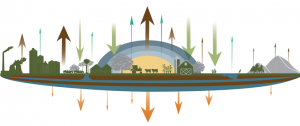California’s new nitrogen assessment highlights promising solutions for reducing fertilizer losses
 A team of researchers spent seven years dissecting, analyzing and reporting on California’s nitrogen cycle, and the results are eye-opening.
A team of researchers spent seven years dissecting, analyzing and reporting on California’s nitrogen cycle, and the results are eye-opening.
Nearly 2 million tons of nitrogen are imported into the state each year. Almost a quarter of it is lost through leaching into groundwater – with runoff from cropland accounting for nearly 90 percent of this leaching. Excess nitrates in drinking water can cause health problems when consumed by at risk populations. Four percent of the state’s nitrogen is lost to the atmosphere as nitrous oxide, a potent greenhouse gas 300 times more potent than carbon dioxide.
But the California Nitrogen Assessment (CNA), released by UC Davis’ Agriculture Sustainability Institute, also provides a never before seen level of detail on nitrogen movement in the state. There’s no silver bullet for reducing environmental impacts while keeping growers profitable. Yet information is power and the more we know, the more we can tailor and prioritize solutions.
The UC Davis team investigated various political, social and economic ideas for reestablishing our state’s nitrogen balance. Two of the most promising solutions for California agriculture to address what the CNA calls “critical control points” include enhancing fertilizer efficiency and expanding carbon markets for agriculture.
Fertilizer efficiency

While many programs exist to help growers manage nitrogen more efficiently, there is still plenty of room to improve. According to the CNA, fresh fruits and veggies only use half of the nitrogen applied to them – the rest is susceptible to loss. It’s also particularly challenging for growers and farm managers to know how much nitrogen to apply, when to apply it, and where, in a way that maximizes returns and minimizes losses. The variability in weather and characteristics of each farm also influence optimal amounts of nitrogen.
That’s why EDF has partnered with the Almond Board of California and UC Davis to research the relationship between nitrate leaching and nitrous oxide emissions as nitrogen efficiency improves. Soil type, climate and irrigation practices all impact the movement of nitrogen applied on farms.
New technologies are also coming on board that allow orchard managers to control irrigation and fertilizer applications together (called fertigation). UC Cooperative Extension conducts regular outreach to growers on these topics and a number of California Certified Crop Advisors have been trained to certify a farm’s nitrogen management plan.
There are also some great in-state resources to help growers be more precise in their fertilizer applications: the University of California’s Sustainable Agriculture and Research Education Program, the California Department of Agriculture’s Fertilizer Research Education Program, and SureHarvest.
Carbon markets
 By studying various nitrogen budgeting management strategies currently used by almond growers, EDF is also examining the possibility of incentivizing nitrous oxide emissions reductions through carbon markets.
By studying various nitrogen budgeting management strategies currently used by almond growers, EDF is also examining the possibility of incentivizing nitrous oxide emissions reductions through carbon markets.
One promising policy instrument to deal with nitrous oxide losses is a protocol for quantifying the amount of avoided emissions that results from improved nitrogen fertilizer management practices. EDF and partners are adapting existing protocols in the voluntary carbon market for use with tree or nut crops in California that would allow growers to participate in already established carbon markets.
Once the protocol is accepted, almond growers and others would be paid for cutting emissions from their operations. This would incentivize greater fertilizer efficiency at scale across the state, with the potential for replication elsewhere.
Companies or individuals interested in offsetting their own carbon footprint could purchase these credits from farmers and thereby help meet their corporate sustainability goals. For example, in 2014 Chevrolet purchased carbon credits that were generated on the grasslands of the Prairie Pothole region in North Dakota.
California is up to the challenge
California has a unique history of agriculture, innovation, and environmentalism. That’s why I’m confident that the state will use the CNA’s findings to implement tangible solutions. That is the best way to address leakages of nitrogen into our environment, and to make the state’s agriculture system more efficient and effective.












